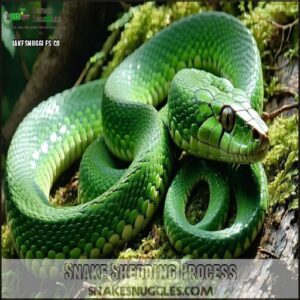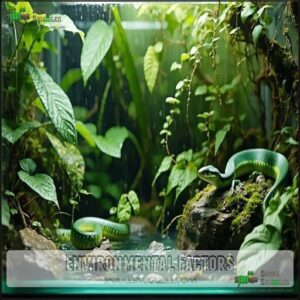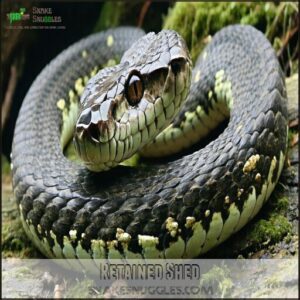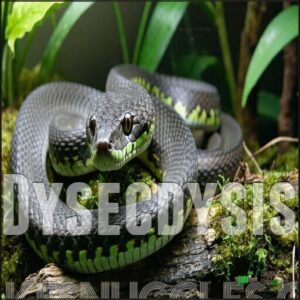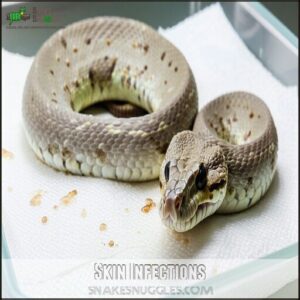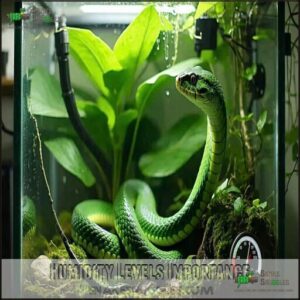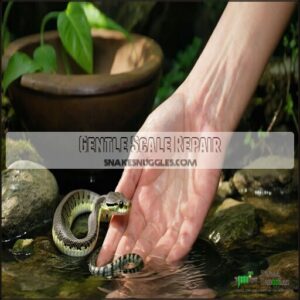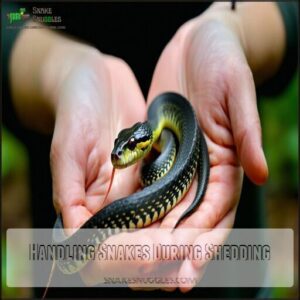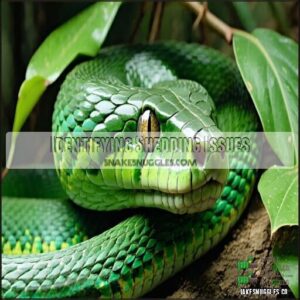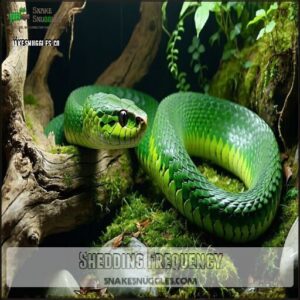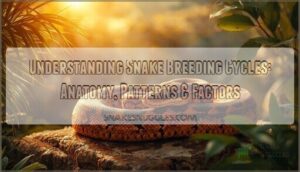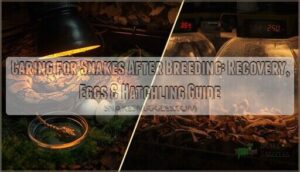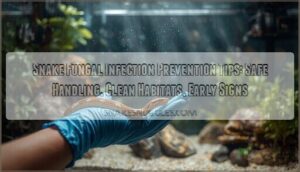This site is supported by our readers. We may earn a commission, at no cost to you, if you purchase through links.
 You’re looking for safe snake shedding home remedies to help your pet snake shed smoothly.
You’re looking for safe snake shedding home remedies to help your pet snake shed smoothly.
To guarantee a healthy shed, you’ll want to maintain ideal humidity levels, provide a warm water soak, and create a humid hide box.
By doing so, you’ll reduce the risk of retained sheds and skin infections.
You’re taking the first step to a successful shed, and with the right techniques, you’ll be well on your way to helping your snake navigate this critical process, and there’s more to explore on how to make this process even smoother.
Table Of Contents
- Key Takeaways
- Snake Shedding Process
- Environmental Factors
- Shedding Problems
- Humidity Levels Importance
- Safe Shedding Remedies
- Handling Snakes During Shedding
- Identifying Shedding Issues
- Nutrition and Hydration
- Shedding Frequency
- Shedding Care and Maintenance
- Frequently Asked Questions (FAQs)
- What can I use to help my snake shed?
- How to get rid of a snake in a shed?
- What can I do with snake skin?
- Can snakes shed in extreme cold temperatures?
- How often do snakes shed after hibernation?
- Do snakes shed more at night or day?
- Can snakes hear during the shedding process?
- Are snakes more aggressive before shedding starts?
- Conclusion
Key Takeaways
- You’ll want to maintain ideal humidity levels, between 50-70%, to support your snake’s shedding process and prevent shedding problems like retained skin or dysecdysis.
- To help your snake shed safely, you can use remedies like misting, humid hide boxes, and warm water soaks, which create a comfortable environment and reduce the risk of complications.
- It’s crucial to monitor your snake’s shedding stages and identify potential issues, such as retained eye caps or incomplete sheds, to provide proper care and prevent further problems.
- By providing a balanced diet, ensuring adequate hydration, and considering vitamin supplements, you’ll help your snake shed smoothly and maintain overall health, so you can support their growth and well-being.
Snake Shedding Process
You’re about to learn how snakes shed their skin, a process called ecdysis, which allows them to grow and maintain healthy scales.
Snakes shed their skin to grow and maintain healthy scales through a process called ecdysis.
As you understand the snake shedding process, you’ll discover it occurs in four stages: pre-shed signs, blue phase, shedding initiation, and shed completion.
Pre-Shed Signs
You’ll notice several pre-shed signs in your snake, including behavioral changes, appetite loss, scale dullness, and reduced activity.
Color changes may also occur, indicating the start of the snake shedding cycle, where humidity plays a vital role in the snake’s skin preparation for shedding.
Blue Phase
During the blue phase, your snake’s skin turns bluish-white, and their eyes cloud over, causing vision impairment.
Key signs include:
- Eye cloudiness
- Skin opacity
- Behavioral changes
- Vision impairment, indicating shed timing is near, requiring proper humidity for shedding to prevent snake shedding problems.
Shedding Initiation
You initiate snake shedding by rubbing against surfaces, triggered by hormone releases and environmental cues.
This process marks a pivotal phase in the snake shedding cycle, where behavioral changes and humidity levels play a significant role in shedding frequency and potential snake shedding problems, particularly those related to shedding frequency.
Shed Completion
You’ve reached shed completion. Here are signs:
- Complete Shed
- Examining Shed
- Post-Shed Health
- Shed Integrity
- Scale Appearance.
Snakes undergo ecdysis to accommodate growth and remove parasites.
Promote proper humidity to avoid stuck shed treatment issues, promoting safe snake shedding and post-shed health with snake shedding assistance for ideal scale appearance.
Environmental Factors
You play a vital role in creating a suitable environment for your snake’s shedding process, and understanding the factors that affect it’s key.
By controlling humidity levels, temperature, and substrate selection, you can help your snake shed safely and effectively, reducing the risk of complications and promoting healthy growth.
Humidity Levels
You monitor humidity levels, typically between 50-70%, to guarantee proper humidity for snake shedding, considering species needs and enclosure size.
This is crucial to prevent mold and maintain air circulation, which is vital for healthy snake shedding humidity in your snake enclosure.
Accurate readings require a reliable humidity monitor, ensuring you can maintain the healthy snake shedding environment needed for your pets.
Temperature Control
You control temperature with heating gradients, ensuring thermostat accuracy for ideal basking spots.
Nighttime drops and species needs guide your temperature control, balancing snake shedding environment with humidity levels.
Creating a stable snake enclosure humidity for healthy snake shedding is crucial, and this is achieved by ensuring humidity levels are appropriate.
Substrate Selection
You select a substrate with good moisture retention for your snake’s enclosure.
Consider the following options for your snake’s habitat:
- Coconut fiber
- Sphagnum moss
- Reptile carpet
- Paper towels
- Indoor/outdoor carpeting
When choosing a substrate, it’s essential to balance burrowing behavior, abrasiveness levels, impaction risk, and cleaning ease for ideal snake shedding and habitat humidity.
Shedding Problems
You’ll encounter shedding problems if your snake’s environment isn’t properly set up, leading to issues like retained shed or dysecdysis.
By understanding the causes of these problems, you can take steps to prevent them and guarantee your snake sheds safely and effectively.
Retained Shed
You’ll encounter retained shed, a common issue, when humidity levels are low.
Stuck Shed Causes include inadequate substrate and poor access to humid hides.
Use shedding aid and increase humidity to prevent scale rot risk and shedding difficulties, or seek veterinary intervention for proper retained shed treatment and home remedies.
Dysecdysis
You’re now dealing with Dysecdysis, a shedding issue.
Recognizing Dysecdysis is key, as it’s often caused by low humidity levels, leading to shedding difficulties and retained shed.
Treating Dysecdysis requires addressing underlying causes and using a snake shedding aid to prevent complications.
Skin Infections
You’ll want to watch for skin infections like Bacterial Infections, Fungal Infections, or Scale Rot, which can arise from shedding issues, affecting reptile health, particularly snake health, and require veterinary care.
Maintaining proper humidity is essential, and monitoring humidity levels can prevent such issues, highlighting the importance of preventative measures and prompt treatment to prevent Blister Disease.
Humidity Levels Importance
You’ll need to maintain ideal humidity levels, between 50-70%, to support your snake’s shedding process.
Maintain ideal humidity levels between 50-70% for a healthy snake shed
By doing so, you’ll help prevent shedding problems, such as retained skin or dysecdysis, and guarantee a healthy environment for your snake to thrive.
Proper Habitat Setup
For proper shedding, your snake’s habitat is key. You’ll need to examine several factors for a healthy environment. These include Enclosure Size, Hiding Spots, Substrate Variety, Water Access, and Enrichment Items.
Here’s a quick guide:
- Maintain proper humidity.
- Guarantee temperature control.
- Offer substrate selection.
- Provide hiding spots.
- Keep water accessible.
Remember, proper humidity levels and environmental conditions are essential for a smooth shed. Maintaining correct enclosure humidity is vital for snake health, ensuring a healthy environment and smooth shed.
Regular Enclosure Cleaning
You’ll maintain ideal humidity levels by performing regular enclosure cleaning, including daily waste removal, substrate replacement, and disinfecting supplies to prevent mold, ensuring a healthy snake shedding process and stable environmental conditions in the snake enclosure.
Proper sanitation requires a suitable enclosure cleaner to ensure proper water sanitation and a clean environment.
This process is crucial for maintaining a healthy snake and preventing diseases, making regular cleaning a vital part of snake care.
Maintaining Optimal Temperature
To guarantee ideal temperature for snake shedding, set up heating gradients with thermostat accuracy.
Provide basking spots and monitor nighttime temperatures, balancing temperature control with proper humidity levels in the snake enclosure to support healthy snake shedding, ensuring thermostat accuracy and healthy snake shedding.
Safe Shedding Remedies
You can help your snake shed safely by using remedies like misting and humid hide boxes to maintain ideal humidity levels.
By using these methods, you’ll create a comfortable environment that supports your snake’s shedding process, reducing the risk of complications and promoting healthy skin.
Misting and Humid Hide Boxes
To promote snake shedding, you’ll create a humidity gradient by misting and using humid hide boxes.
This helps prevent retained shed, keeping humidity levels ideal for snake comfort.
It also prevents mold, all while maintaining proper humidity.
Warm Water Soaks
You’ll use warm water soaks to help with shedding problems, like stuck shed.
Soak your snake in warm water, considering soak duration and water temperature, to loosen the shed, especially during the shedding stage.
Add solutions to increase humidity, making the process easier and safer, which is crucial for a successful shed, particularly when dealing with shedding problems.
Gentle Scale Repair
You’ll gently repair scales with a warm water-soaked cloth, applying Neosporin to infected areas.
Considering DIY repair risks and the importance of humidity in Scale Damage Prevention, to aid your snake’s shedding process with natural remedies, while being mindful of the use of vegetable oil for stuck sheds.
Handling Snakes During Shedding
When you’re handling snakes during shedding, to minimize contact is vital, as they can be sensitive and have impaired vision.
You should use gentle handling techniques, such as slow movements and a confident grip, to make certain a safe and stress-free experience for both you and your snake.
Minimizing Handling
When shedding, reduce stress by avoiding handling.
Wait 24-48 hours post-shed, observe behavior, and maintain a stress-free environment with proper humidity levels and water for snake shed to minimize snake discomfort.
This will guarantee safe handling and ensure the snake’s well-being during this critical period.
Gentle Handling Techniques
When handling snakes during shedding, you’ll want to master a safe grip, using a gradual approach to support their body.
Avoiding stress and discomfort, creating a stress-free environment for safe handling, is crucial.
Minimizing snake discomfort with careful body support techniques is also essential to ensure the snake’s well-being.
Post-Shed Care
After handling, examining shed skin helps identify retained patches.
You’ll want to maintain a clean environment, guarantee balanced nutrition, and follow a hydration schedule to support snake health, keeping humidity levels stable for ideal snake shedding and overall snake care.
Promoting healthy snake skin is crucial, and to achieve this, it’s essential to keep humidity levels stable, which is part of ideal snake care.
Identifying Shedding Issues
You’ll need to identify shedding issues in your snake, such as retained eye caps or incomplete sheds, to provide proper care.
By recognizing these problems, you can take steps to address them and guarantee a safe and healthy shedding process for your pet snake.
Retained Eye Caps
You’ll encounter retained eye caps, a common snake shedding problem.
Signs include a cloudy, grainy eye appearance.
- Soaking solutions
- Lubricating agents
- Veterinary assistance can help with Eye Cap Removal and Preventing Infections, especially in cases of retained shed, a common snake shedding issue.
Incomplete Sheds
You identify incomplete sheds by retained skin.
| Cause | Prevention |
|---|---|
| Low humidity | Increase humidity |
| Poor nutrition | Balanced diet |
| Inadequate temperature | Ideal temperature |
| Incomplete sheds | Snake shedding aid |
| Retained shed | Humidity levels adjustment |
Skin Damage
You notice skin damage, including Scale Rot, Abrasions, or Lesions, which can lead to:
- Retained shed
- Skin infections
- Scar Tissue, indicating incomplete snake shed or Blister Disease, requiring prompt care to prevent further issues.
Proper humidity helps prevent incomplete shedding issues, which is a critical factor in maintaining healthy skin for snakes.
Nutrition and Hydration
You play a vital role in supporting your snake’s shedding process through proper nutrition and hydration.
By providing a balanced diet, ensuring adequate hydration, and considering vitamin supplements, you can help your snake shed safely and maintain overall health.
Balanced Diet
You guarantee your snake gets a balanced diet with proper nutrient absorption through dietary variety, considering supplementation needs and prey gutloading to prevent obesity.
Providing essential nutrients for a healthy shedding process, which is key to a snake’s overall nutrition and well-being, in its snake diet.
Proper Hydration
Proper snake hydration is key for healthy snake shedding.
Water availability impacts skin elasticity.
Make certain your snake has fresh water always.
Drinking frequency depends on species needs.
Watch for dehydration signs like sunken eyes.
Soaking benefits include loosening old skin.
Maintain proper humidity too.
- Fresh water daily
- Large water dish
- Check for dehydration
- Consider soaking
- Monitor humidity levels
Vitamin Supplements
When supplementing your snake’s diet, consider vitamin A for skin health and calcium for bone growth.
Follow dosage guidelines to avoid toxicity, and monitor for deficiency signs, as absorption factors can impact effectiveness, affecting snake shedding and overall reptile health, and consult veterinary care for guidance on supplement interactions.
Vitamin D3 is essential for calcium absorption needs **in reptiles.
Shedding Frequency
You’ll find that snake shedding frequency varies by age and species.
Young snakes shed monthly, while adults shed a few times a year.
Growth rate and seasonal changes also impact shedding frequency.
As snakes age, their shedding cycle slows down.
Species variation plays a role too, with some snakes shedding more often than others.
Health issues can affect shedding frequency, so monitoring your snake’s shedding stages is important.
Understanding age influence and species variation helps you anticipate your snake’s shedding frequency, ensuring you provide the best care for a healthy shedding cycle.
This knowledge helps you prepare.
Shedding Care and Maintenance
You’ll need to provide proper care and maintenance to guarantee your snake sheds safely and effectively.
By following the right techniques, such as cleaning and disinfecting, providing rough surfaces, and monitoring humidity levels, you can help your snake shed comfortably and reduce the risk of shedding problems, which involves providing the right environment for your pet.
Cleaning and Disinfecting
After ensuring your snake has the right nutrients for healthy shedding, it’s time to think about their home. Preventative cleaning is key to snake health.
Here’s how to keep their space spotless:
- Always use safe disinfectants.
- Maintain water bowl hygiene.
- Practice substrate sanitation.
Enclosure sterilization prevents skin infections. Regular cleaning keeps humidity levels right and supports successful snake shedding. Remember, a clean home means a happy snake.
Providing Rough Surfaces
You provide rough surfaces, like bark or branches, to aid snake shedding, promoting scale health and reducing shedding problems.
Textured hides and rock variety also help, keeping your snake’s skin healthy and strong, especially in humid environments.
Monitoring Humidity Levels
Monitor humidity levels with a digital probe hygrometer, considering species requirements and humidity gradients.
- Check Hygrometer Calibration
- Adjust Automated Systems
- Observe Natural Indicators
Maintain proper humidity control to increase humidity if needed, ensuring that the environment is well-suited for the species, with humidity gradients being a key factor.
Frequently Asked Questions (FAQs)
What can I use to help my snake shed?
Don’t worry, you’re not alone.
You can help your snake shed with warm water soaks, humid hides, and gentle scale removal to make the process smoother and safer for your pet.
How to get rid of a snake in a shed?
You’ll want to humanely capture the snake, then release it far from your shed, using gloves and a secure container to avoid injury.
What can I do with snake skin?
You can preserve, study, or dispose of snake skin, taking care to handle it gently to avoid damage, and considering its potential educational or scientific value.
Can snakes shed in extreme cold temperatures?
You shouldn’t keep snakes in extreme cold temperatures, as it hinders shedding, causing stress, and potentially leading to health issues, so maintain a suitable temperature range for your snake’s species.
How often do snakes shed after hibernation?
You’ll notice snakes shed more frequently after hibernation, typically every 1-3 months, as they grow and replace old skin, with frequency decreasing as they age and growth slows down.
Do snakes shed more at night or day?
Like a clock, snakes shed at any time.
They shed more at night, as it’s a private process, and darkness provides a sense of security and comfort.
Can snakes hear during the shedding process?
You’ll find snakes can’t hear during shedding, as their ear scales are covered, temporarily impairing hearing, making them more sensitive to vibrations and movements around them instead.
Are snakes more aggressive before shedding starts?
You’re going through a shedding storm, and snakes can become more aggressive before shedding starts, due to discomfort and temporary blindness.
So handle them gently and with care during this sensitive phase.
Conclusion
Smoothly shedding snakes showcase spectacular skin renewal.
You’re now skilled at using safe snake shedding home remedies, ensuring a healthy shed.
By maintaining ideal humidity and providing warm water soaks, you’ll reduce retained sheds and skin infections, making the process smoother for your pet, with these effective safe snake shedding home remedies.

